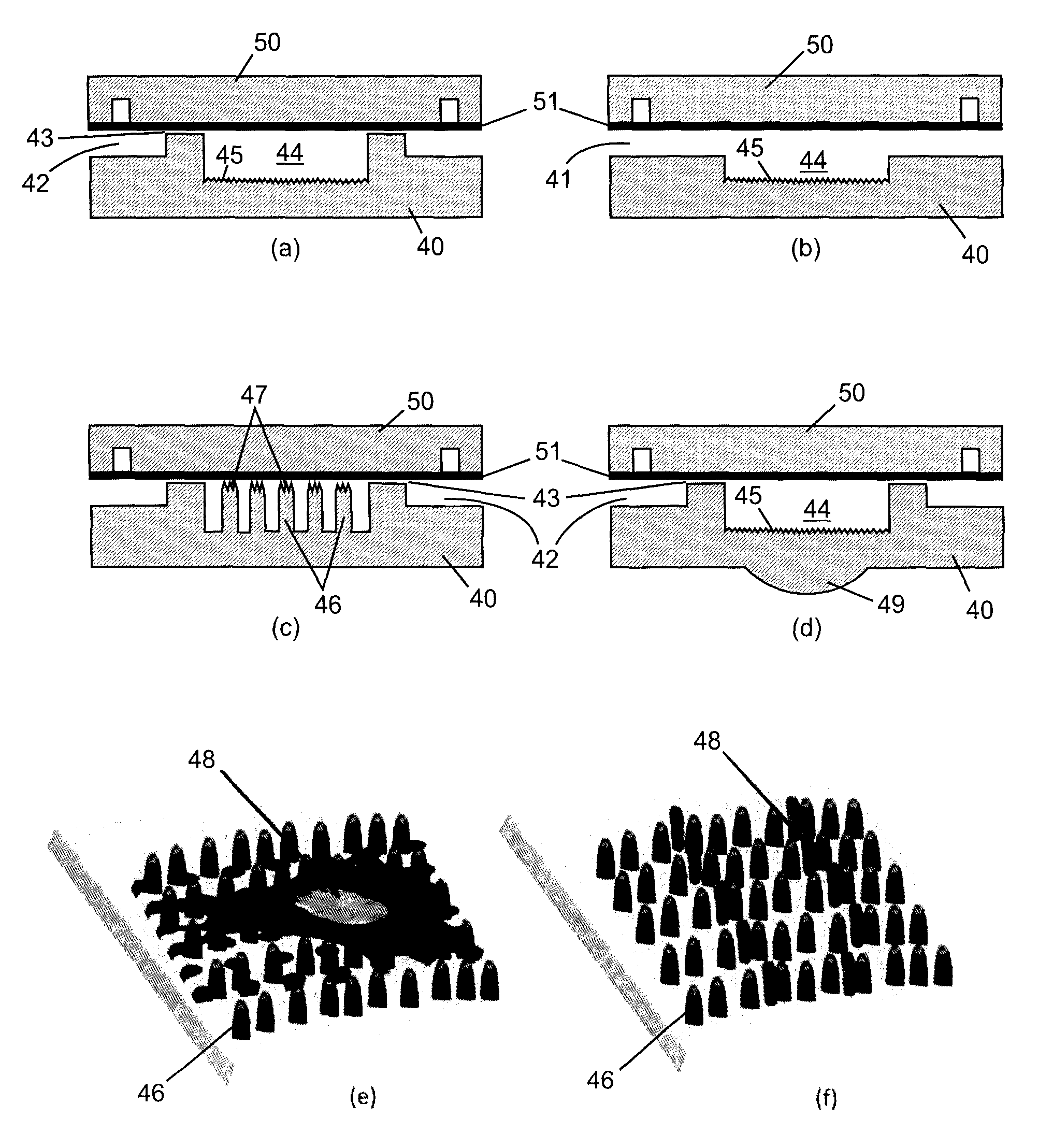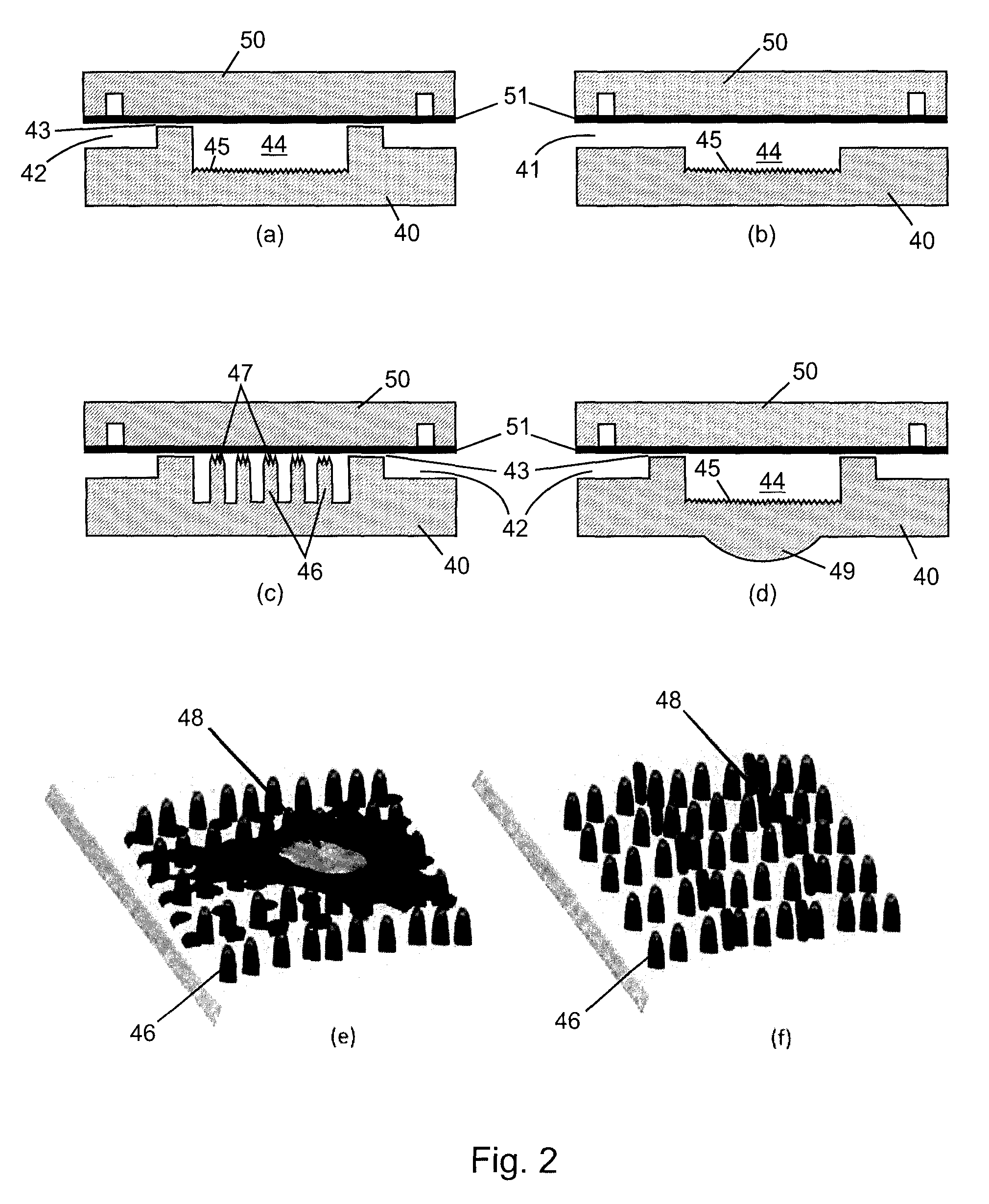However, there is a need for methods that detect bioaffinity interactions without molecular labels, especially for biomolecular and cellular interactions, where labeling is problematic and can interfere with their biological properties.
Additionally, these methods are not suitable for the rapid pathogen or cancer detection as they require extensive blood culture of the pathogen or diseased tissue in the central laboratory prior to the detection of antibodies.
Even though developments in the field of high-throughput screening (HTS) and computational chemistry greatly accelerated and facilitated the drug finding process, there are significant limitations to overcome.
Currently employed assays that rely on cell culture in Petri dishes and subsequent fluorescence-based live-cell imaging and biomolecule detection are slow, cumbersome and cannot meet these requirements.
The resulting variability in the concentration of applied reagents hinders fair and quantitative comparisons and limits the ability of HCCS to resolve small differences in cell signaling responses.
This issue is exacerbated in more complex protocols, such as sequential exposure of cells to different media, because of errors that accumulate when changing media.
Moreover repeated media aspirations might unintentionally remove cells from the wells.
Because these assays are also difficult to miniaturize, HCCS experiments may consume large quantities of expensive or valuable cells and reagents.
Finally HCCS still relies on fluorescent tags which may trigger unwanted steric hindrance effects.
Consequently, the research into the effect of cues (single or multiple) on cellular response to date has been limited by the lack of robust and reproducible methods for homogeneous material production, precise control of the cell culture conditions and in situ real-time label-free monitoring of cellular response, cell behavior, cell viability or biomolecular binding interactions.
Specifically, the material production methods have lacked the control required to reproducibly fabricate homogeneous surfaces that will allow investigations into specific interactions between cells and isolated variables i.e. a precisely defined nanoscale patterns in a defined space with control over the induced change in topography and associated changes to surface energy.
The commonly employed well-based cell culture methods are costly and suffer errors in liquid dispensing, both manually and robotically, thus precluding uniform handling of each well which in turn limits how finely signaling responses may be resolved.
Finally, while the use of fluorescent imaging techniques for cell analysis can provide information not easily attainable by other methods, they are usually confounded by the need to over-express the signaling protein of interest and by possible effects of the fluorescent marker on the protein's function.
However, despite a growing focus from the microfluidic research community, both PCR and ELISA rely on fluorescence labels, which increase the complexity and cost of the assay.
In addition to the requirement for a labeled recognition element, these techniques typically require complex optical systems which typically consist of a large microscope or a microplate reader.
As a result, the field of microfluidics has yet to produce many commercial devices for disease diagnostics (Myers 2008).
However, the assays in these studies were performed using traditional cell-culture methods and analyzed using live fluorescence microscopy with inherent drawbacks of these techniques which may have resulted in misleading interpretation of results due to error in liquid handling, perturbation caused by fluorescent markers and low throughput in which only a few cells were imaged for each experimental run.
However, FC is limited to characterizing fluorescent signals (GFP-fusion proteins, immunofluorescence, and fluorogenic substrates to intracellular enzymes) (Fayet 1991; Nolan 1998; Krutzik 2006), which can lead to steric hindrance and is incapable of important time-dependent measurements of the cell population.
However, only a limited region of a plate can be scanned thus limiting the throughput of the technique.
This is particularly due to uneven introduction of solution over the whole slide or plate, and the serial process of laser scanning.
Furthermore, cells analyzed using both methods are usually grown in traditional flasks, slides or Petri-dishes before analysis, and so uniformity of environment is limited to that of the flask or dish.
Notably, cell-cell contact is not controllable, and diffusible secretions are maintained in the culture environment.
This is in part due to the difficulty in reproducibly fabricating nanostructured surfaces within microfluidic cell culture devices.
However, controlling the regularity, geometry and / or spacing of the nanoparticle arrays using these techniques is difficult to achieve limiting the reproducibility of the experimental measurements.
The compatibility of materials and reagents involved in these processes is difficult to achieve.
This can result in topographical surface variations induced by sample-to-sample fabrication differences.
Furthermore, PDMS soft-lithography fabrication technique itself is not well suited for mass production of microfluidic devices which hinders their application in industry, including medical diagnosis and pharmaceutics.
Further, microfluidic devices with nanostructured hydrophobic surfaces have been developed to control surface tension and liquid pressure in fluid flow channels (Extrand 2005), but the standard techniques used to nano-pattern the channel surfaces are insufficiently flexible to permit simple and fast patterning of nanostructures, especially different nanostructured patterns, at specific locations in the channels or chambers of the device but not at others.
Thus, different design features within the same device are difficult to accomplish and the designs are difficult to adapt to the requirements of plasmonic detection techniques.
In general, prior art systems have one or more deficiencies.
There is a lack of an integrated microfluidic system that relies on non-invasive, label-free detection technologies including plasmonic techniques such as surface plasmon resonance (SPR) (e.g. reflection-mode SPR, transmission-mode SPR, localized surface plasmon resonance (LSPR)) and surface-enhanced Raman spectroscopy (SERS) for monitoring cell behavior, cell-substrate interactions, cell response to stimuli and biomolecule detection.
There is a lack of fabrication techniques allowing monolithically integrated nanostructured cell culture system in long-term biocompatible materials with simultaneous cell guiding functionality and plasmonic detection capability using topographical cues and nanostructure plasmonic response, respectively.
There is poor control of cellular microenvironment in Petri-dish or microwell plates.
There is lack of reproducible and robust surface topography (nanopatterning) for precise control of cellular response and cell-substrate interaction studies.
There is a lack of integrated nanostructured surface within microfluidic channels.
And, there is a lack of low-cost and rapid mold fabrication techniques that allow interchangeable nano- and micro-structure design.
 Login to View More
Login to View More 


